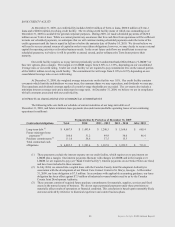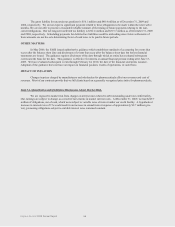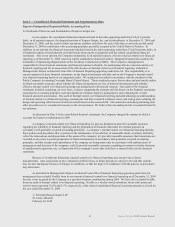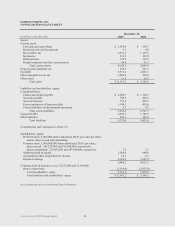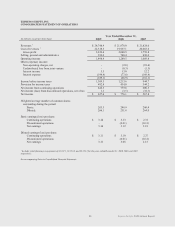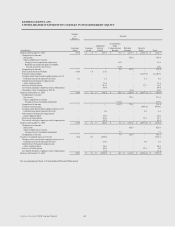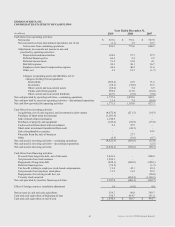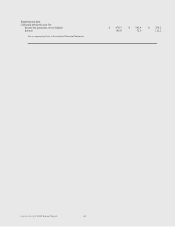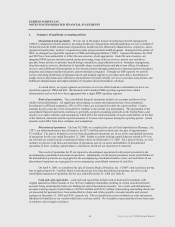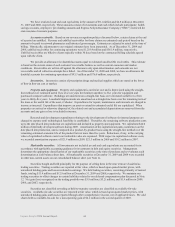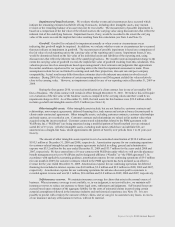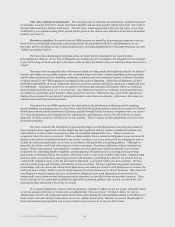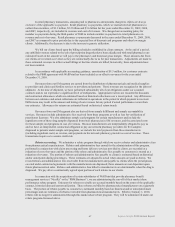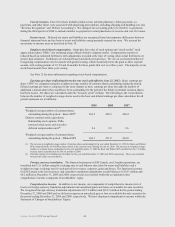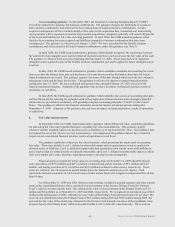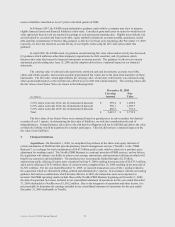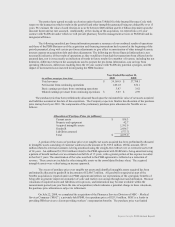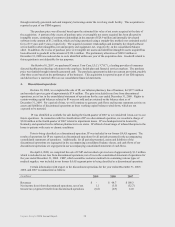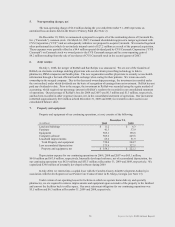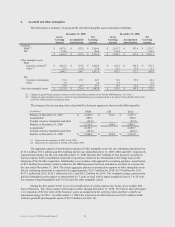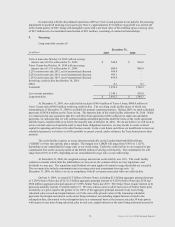Express Scripts 2009 Annual Report Download - page 67
Download and view the complete annual report
Please find page 67 of the 2009 Express Scripts annual report below. You can navigate through the pages in the report by either clicking on the pages listed below, or by using the keyword search tool below to find specific information within the annual report.
Express Scripts 2009 Annual Report
65
Impairment of long lived assets. We evaluate whether events and circumstances have occurred which
indicate the remaining estimated useful life of long lived assets, including other intangible assets, may warrant
revision or the remaining balance of an asset may not be recoverable. The measurement of possible impairment is
based on a comparison of the fair value of the related assets to the carrying value using discount rates that reflect the
inherent risk of the underlying business. Impairment losses, if any, would be recorded to the extent the carrying
value of the assets exceeds the implied fair value resulting from this calculation (see Note 4 and Note 8).
Goodwill. Goodwill is evaluated for impairment annually or when events or circumstances occur
indicating that goodwill might be impaired. In addition, we evaluate whether events or circumstances have occurred
that may indicate an impairment in goodwill. The measurement of possible impairment is based on a comparison of
the fair value of each reporting unit to the carrying value of the reporting unit’s assets. Impairment losses, if any,
would be determined based on the fair value of the individual assets and liabilities of the reporting unit, using
discount rates that reflect the inherent risk of the underlying business. We would record an impairment charge to the
extent the carrying value of goodwill exceeds the implied fair value of goodwill resulting from this calculation. This
valuation process involves assumptions based upon management’s best estimates and judgments that approximate
the market conditions experienced for our reporting units at the time the impairment assessment is made. These
assumptions include but are not limited to earnings and cash flow projections, discount rate and peer company
comparability. Actual results may differ from these estimates due to the inherent uncertainty involved in such
estimates. During 2009, the valuations of certain reporting units in our EM segment yielded fair values relatively
close to the carrying value. However, no impairment existed for any of our reporting units at December 31, 2009 or
2008.
During the first quarter 2010, we received notification of a client contract loss in one of our smaller EM
lines of business. The client contract will remain in effect through December 31, 2010. We believe this will require
a re-evaluation of the fair value of the business’ assets as compared to the carrying values and there could be an
impairment charge in 2010. As of December 31, 2009, the total assets for this business were $39.8 million which
includes goodwill and intangible assets of $23.9 million (see Note 14).
Other intangible assets. Other intangible assets include, but are not limited to, customer contracts and
relationships, non-compete agreements, deferred financing fees, trade names and certain advance discounts paid to
clients under contractual agreements. Other intangible assets, excluding customer contracts, customer relationships
and trade names, are recorded at cost. Customer contracts and relationships are valued at fair market value when
acquired using the income method. Customer contracts and relationships related to the PBM agreement with
WellPoint, Inc. (“WellPoint") are being amortized using a modified pattern of benefit method over an estimated
useful life of 15 years. All other intangible assets, excluding trade names which have an indefinite life, are
amortized on a straight-line basis, which approximates the pattern of benefit, over periods from 1 to 20 years (see
Note 8).
The amount of other intangible assets reported is net of accumulated amortization of $238.4 million and
$195.5 million at December 31, 2009 and 2008, respectively. Amortization expense for our continuing operations
for customer-related intangibles and non-compete agreements included in selling, general and administrative
expense was $35.2 million for the year ended December 31, 2009 and $33.7 million for the years ended 2008 and
2007, respectively. We have entered into a 10-year contract with WellPoint under which we will provide pharmacy
benefit management services to WellPoint and its designated affiliates (“NextRx” or “the PBM agreement”). In
accordance with applicable accounting guidance, amortization expense for our continuing operations of $9.5 million
(for one month in 2009) for customer contracts related to the PBM agreement has been included as an offset to
revenue for the year ended December 31, 2009. Amortization expense for our continuing operations for deferred
financing fees included in interest expense was $4.0 million, $2.4 million and $2.2 million in 2009, 2008 and 2007,
respectively. Amortization expense for our continuing operations for advance discounts paid to customers is
recorded against revenue and was $0.1 million, $0.6 million and $2.8 million in 2009, 2008 and 2007, respectively.
Self-insurance reserves. We maintain insurance coverage for claims that arise in the normal course of
business. Where insurance coverage is not available, or, in our judgment, is not cost-effective, we maintain self-
insurance reserves to reduce our exposure to future legal costs, settlements and judgments. Self-insured losses are
accrued based upon estimates of the aggregate liability for the costs of uninsured claims incurred using certain
actuarial assumptions followed in the insurance industry and our historical experience (see Note 13). It is not
possible to predict with certainty the outcome of these claims, and we can give no assurances any losses, in excess
of our insurance and any self-insurance reserves, will not be material.


